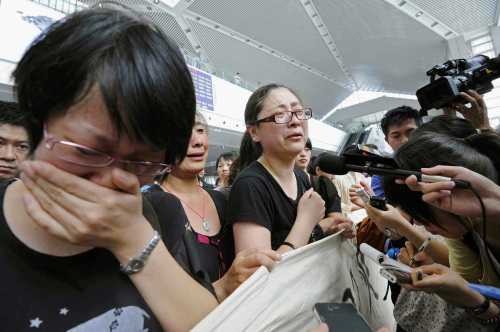BEIJING (AP) -- Design flaws in signal equipment and human error caused last weekend's high-speed train crash in China that killed at least 39 people, a railway official said Thursday.
The preliminary finding comes in the face of public anger about the government's handling of the accident near Wenzhou in Zhejiang province.

Premier Wen Jiabao, who arrived in Wenzhou on Thursday to check on the investigation and the conditions of the survivors, has called for a sweeping and transparent probe into the crash between two bullet trains, which also hurt more than 190 people.
Six train cars derailed and four fell about 65 to 100 feet (20 to 30 meters) from a viaduct Saturday night after one train plowed into the back of another train that had stalled after being hit by lightning.
An Lusheng, head of the Shanghai Railway Bureau, said there were design problems with the signal light equipment at the Wenzhou South Station and dispatchers did not send any warnings after the lightning strike.
“After the lightning strike caused a failure, an interval signal machine that should have shown a red light mistakenly upgraded it to a green light instead,” An said in comments carried by state broadcaster CCTV.
The Beijing National Railway Research and Design Institute of Signal and Communication, which designed the signal equipment, on Thursday issued a letter of apology to the families of the victims and the injured passengers.
It said it would cooperate with the investigation and would “have the courage to assume responsibility and accept the punishment deserved.”
Wen's visit comes a day after more than 20 relatives of people who died in the crash gathered at the Wenzhou South Station, holding banners demanding answers regarding the accident's cause, Chinese media reported.
“After such a big thing has happened, the railway departments cannot hide behind while they let the local governments deal with it and solve it. They are slow and won't show their faces. Is it the government that wants to protect them, or has the government been threatened by them?” one man surnamed Lin who lost his elder brother, Lin Xiao, in the crash, told the Yangcheng Evening News.
The government has ordered a two-month safety campaign for its railway system amid questions about how the crash occurred. Wen called for the campaign to be widened to target all transport infrastructure, coal mines, construction sites, and industries dealing with dangerous chemicals.
The accident was the biggest blow yet to China's burgeoning high-speed rail ambitions that have been highlighted as a symbol of the countries rising economic and technological prowess.
Rapid expansion of the services has been dogged by concerns about safety, corruption scandals and criticism that schedules are impractical and tickets too expensive for ordinary Chinese. Open just one month, the much-hyped 820-mile (1,318-kilometer) Beijing-Shanghai line has been plagued by power outages and other malfunctions.
Saturday's accident outside the eastern city of Wenzhou prompted an outpouring of anger among the public and even in the usually docile state media, with questions posed over the cause of the crash and the government's handling of the aftermath.
The firing of three top officials at the Shanghai Railway Bureau did little to tamp down criticism that authorities made only passing attempts to rescue survivors while ordering tracks swiftly cleared to restore service.
<한글 기사>
中, 고속철사고 '신호설비 결함' 결론
중국 정부가 39명의 목숨을 앗아간 원저우(溫州) 고속열차 추돌 참사의 원인이 신호 설비 및 관제 시스템 결함에 있다고 잠정 결론을 내렸다.
앞서 발표된 것과 달리 신호ㆍ관제시스템에 문제가 있다는 결론이 나옴에 따라 이번 사고가 '인재(人災)'라는 비판 여론은 더욱 거세질 전망이다.
28일 관영 중국중앙(CC)TV과 신화통신에 따르면 안루성(安路生) 상하이 철도국 장은 이날 오전 원저우에서 열린 국무원 사고 조사팀 1차 전체회의에서 초기 조사 결과 원저우남역의 신호 설비 결함이 이번 사고를 일으킨 것으로 파악됐다고 보고했다.
안 국장은 원저우남역의 신호 설비의 설계에 중대한 결함이 있어 벼락을 맞고 고장이 난 뒤 붉은 신호등을 켜야 할 구간에서 녹색 신호등이 잘못 나타났다고 설명 했다.
그러나 사고 구간을 관리하던 원저우남역의 당직자는 신호등 고장 사실을 알아 채지 못해 적절한 조처를 하지 못했다고 안 국장은 덧붙였다.
문제가 된 신호등 설비는 베이징의 한 연구소가 설계한 것으로 2009년부터 생산 돼 현장에서 쓰이기 시작했다.
그는 "이번 사고는 설비 품질과 철도 부문 인력의 자질, 현장 통제 능력 문제 등이 복합돼 나타난 것으로 중국 철도의 안전 관리 능력이 아직 부족하다는 것을 보 여줬다"고 평가했다.
사고 직후 중국 당국은 항저우(杭州)에서 푸젠(福建)성 푸저우(福州)로 향하던 둥처 D3115호가 벼락을 맞아 동력을 상실하며 경보 시스템까지 파손돼 이를 모르고 시속 200㎞의 전속력으로 뒤따라오던 베이징(北京)발 푸저우행 둥처 D301호가 앞 열 차를 들이받았다고 밝힌 바 있다.
일주일도 채 안 돼 사고 원인이 천재지변에 의한 고속열차 고장에서 신호ㆍ관제 체계 고장으로 뒤바뀜에 따라 조사 결과에 대한 신뢰성이 또다시 의심받게 됐다는 지적이 나온다.
아울러 국무원 사고 조사팀은 9월 중순 최종적인 조사 결과를 내놓겠다고 밝혔다.
조사팀장을 맡고 있는 국가안전감독국 뤄린(駱琳) 국장은 "조사팀은 과학적 원칙을 존중하고 전문가들의 역할을 충분히 인정하는 가운데 진지하게 조사를 진행할 것"이라며 "배차 상황, 지령 내용, 통과 기록, 블랙박스 정보 등 내용을 확인할 것"이라고 설명했다.
많은 중국인은 인터넷에서 사망자가 39명이라는 정부의 공식 발표도 믿지 못하겠다는 반응을 보이는 등 이번 사고에 대한 정부의 각종 발표 내용에 대해 극도의 불신감을 드러내고 있다.
이 같은 민심을 우려한 듯 국무원은 전날 원자바오(溫家寶) 총리가 참석한 가운 데 열린 상무위원회에서 "과학적이고 법에 근거한 실사구시의 원칙에 따라 사고 조사를 진행해야 한다"며 "조사 및 사건 처리 과정은 공개적이고 투명해야 하며 그 결 과를 사회에 공개해 인민들에게 책임 있는 모습을 보여야 한다"고 강조했다.
또한 국무원은 "사실 관계를 명확히 밝혀낸 뒤 법규에 따라 책임을 물을 것"이 라고 강조해 향후 철도부 관계자들에 대한 대대적인 문책 인사 및 형사 처벌이 예상 된다.
한편 국무원 합동 조사반의 현장 조사가 진행되고 있는 동안 대검찰청에 해당하는 최고인민검찰원도 전날부터 조사팀을 현장에 보내 책임자에 대한 사법처리 수순 이 진행될 것임을 예고했다.


















![[Today’s K-pop] BTS pop-up event to come to Seoul](http://res.heraldm.com/phpwas/restmb_idxmake.php?idx=642&simg=/content/image/2024/04/17/20240417050734_0.jpg&u=)